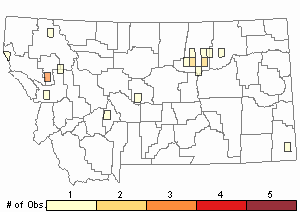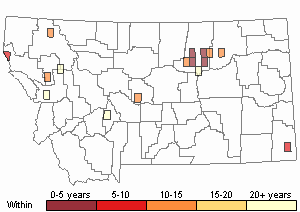View in other NatureServe Network Field Guides
NatureServe
Montana
Utah
Wyoming
Idaho
Wisconsin
British Columbia
South Carolina
Yukon
California
New York
Hairy Water Fern - Marsilea vestita
Native Species
Global Rank:
G5
State Rank:
S3
C-value:
4
Agency Status
USFWS:
USFS:
BLM:
External Links
General Description
PLANTS: Perennial, aquatic ferns that grow from shallow, branched rhizomes to form colonies (Lesica et al. 2012).
LEAVES: Plants have alternate, clover-like leaves. Leaf petioles are longer than the blades. Leaf blades are palmately divided into 4 equal, broadly ovate, pubescent to glabrous pinnae (leaflet) (Lesica et al. 2012).
SPOROCARPS: Nut-like or bean-shaped structures found attached the bases of petioles. Sporocarps slightly nod and may be stalked. Inside the sporocarp the sori are arranged in two alternating rows (Lesica et al. 2012). Each sorus contains microsporangia and megasporangia (Nagalingum et al. 2007). Refer to REPRODUCTIVE CHARACTERISTICS.
The specific epithet vestita is derived from the Latin word vestis meaning “clothing” or “garment” in reference to its densely pubescent young sporocarps, which appear to be clothed in hair. Marsilea is for Count Luigi Marsigli, an Italian naturalist and mycologist of the 18th century (Giblin et al. [eds.] 2018).
Phenology
Sporocarps are produced from April through October (Johnson in Flora of North America [FNA] 2019).
Diagnostic Characteristics
Montana has 2 native species of
Marsilea. Both are aquatic perennials that grow from shallow, branched rhizomes to form colonies. The leaves of both species are alternate and clover-like, the blades divided into 4 broadly ovate pinnae which, all together, are shorter than the petiole.
Hairy Water Fern-
Marsilea vestita, native
*Leaf petioles: 1-20 cm long or up to 40 when floating.
*Pinnae: 3-19 mm long and sparsely pubescent to glabrous.
*Sporocarps: Mature sporocarps are 3-6 mm long, slightly nodding and pubescent but becoming glabrous with age.
*Sporocarp teeth: The lower tooth is usually about 0.5 mm long while the upper tooth is longer and acute.
Pepperwort-
Marsilea oligospora, native, SOC
*Leaf petioles: 3-6 cm long
*Pinnae: 6-15 mm long and pilose.
*Sporocarps: Mature sporocarps are 5-6 mm long, nodding and long-hairy but glabrous with age.
*Sporocarp teeth: The lower tooth is usually about 0.5 mm long while the upper is usually blunt and smaller than the upper or absent.
Range Comments
Hairy Water Fern ranges from British Columbia to Saskatchewan south to Mexico and South America (Lesica et al. 2012).
Observations in Montana Natural Heritage Program Database
Number of Observations: 21
(Click on the following maps and charts to see full sized version)
Map Help and Descriptions
Relative Density

Recency



 (Observations spanning multiple months or years are excluded from time charts)
(Observations spanning multiple months or years are excluded from time charts)
Habitat
The preferred habitat of Hairy Water Fern is fresh to saline, shallow water of ponds, reservoirs, and sloughs found in plains and valleys of Montana (Lesica et al. 2012). Hairy Water Fern requires habitats that have both wet and dry seasonal periods (Chau et al. 2014).
Ecology
LIGHT AND DEVELOPMENT
When grown in the absence of light, the photosynthetic pinnae of Hairy water fern develop but do not expand and instead become elongated, linear, and pale (Gaudet 1965). However, the development of stomata and the elongation of the petioles suggest that leaf development originates from within the leaf itself and is not controlled by the rest of the plant. Individuals grown without light also exhibit lower growth rates and lower foliar weight.
NYCTINASTY
Marsilea species are the only group of ferns that exhibit nyctinasty, or daily movement of leaf orientation (Petlewski et al. 2019). During the day, they assume a more or less horizontal position in order to maximize capture of sunlight and then change orientation by moving into a vertical position at night (Minorsky 2019). The mechanism by which this occurs is the pulvinus joint found at the swollen base of the leaf stalk which moves with water inflow or outflow to the pulvinus motor cells (Iwai et al. 2016). Nyctinastic movement in Marsilea species matches the rhythm of transpiration through opening and closing of stomata (Iwai et al. 2016).
PARASITISM
Parasitism by numerous insect species, including weevils from the genus Echinocnemus and several wasp species, has been observed on Marsilea mollis in Arizona (Mauz et al. 2009). Endalus celatus, another weevil species, has been associated with M. mucronata (Mauz et al. 2009). In these cases, adults feed on the edges of the leaves and females deposit their eggs in the sporocarps (Board et al. 1971). After hatching, larvae feed on the spores inside the sporocarps and then pupate in the resulting empty cavity (Board et al. 1971). Similar weevil and wasp interactions may exist for other Marsilea species.
Reproductive Characteristics
SPOROCARPS
Sporocarps are bean-shaped or nut-like structures that are attached by a stalk to the bases of leaf petioles (Nagalingum et al. 2006). When they are young, sporocarps are softer and may be green but they become very hard and brown with age. Beneath the thick, hard wall of a mature sporocarp, there are 2 rows of sori all attached to a surrounding mucilaginous ring (Bilderback 1978). Sporocarps are specialized reproductive structures that are infolded and fused to contain the sori (Pryer et al. 2009). These structures, unique to Marsileaceae, release individuals from the need to develop mature, sexual leaves and also allow them to become sexually mature earlier than other ferns (Pryer et al. 2009). This is an advantage particularly beneficial for organisms occupying habitats with uncertain conditions because once the conditions are favorable for reproduction, the individual is ready to germinate (Pryer et al. 2009).
SORI
Each bisporaginate sorus is surrounded by a thin indusium and contains two types of sporangium: Megasporangium, which produce haploid spores that develop into female gametophytes, and microsporangium, which produce haploid spores that develop into male gametophytes (Nagalingum et al. 2007). The indusia of adjacent sori are partially fused (_obtained).
LIFE CYCLE
The life cycle of Marsilea are very unique in that they rely on the occurrence of both wet and dry periods to complete their reproduction (Chau et al. 2014). Germination of developed sporocarps occurs once the sori have matured and the entire sporocarp is hydrated during the rainy season, at which point the mucilaginous ring surrounding the sori expands dramatically and ruptures the sporocarp (Nagalingum et al. 2007). At this point spores germinate in a gametophytic phase for up to 2 days after which the sporophyte quickly develops rhizomes and leaves (Pryer et al. 2009). Development of new sporocarps follows the end of the growing season when the habitat dries completely (Pryer et al. 2009). Sporocarps are remarkably tolerant of desiccation and can germinate successfully even after 100 years of dormancy (Gosejohan et al. 2017).
Management
Conservation of preferred ephemeral habitats is essential to maintaining existing populations of Hairy Water Fern.
Stewardship Responsibility
Threats or Limiting Factors
Marsilea villosa, an endemic, Hawaiian species very closely related to M. vestita and M. oligospora, has experienced a drastic decrease in its range despite attempted conservation and management of populations (Wester et al. 2006). This is most likely due to its narrow habitat requirements combined with human alteration and aggressive invasive species. Off-road vehicles as well as trampling and grazing by cattle have also been suggested as contributors to the dwindling distribution.
References
- Literature Cited AboveLegend:
 View Online Publication
View Online Publication Lesica, P., M.T. Lavin, and P.F. Stickney. 2012. Manual of Montana Vascular Plants. Fort Worth, TX: BRIT Press. viii + 771 p.
Lesica, P., M.T. Lavin, and P.F. Stickney. 2012. Manual of Montana Vascular Plants. Fort Worth, TX: BRIT Press. viii + 771 p.
- Additional ReferencesLegend:
 View Online Publication
View Online Publication
Do you know of a citation we're missing? Eggers, M.J.S. 2005. Riparian vegetation of the Montana Yellowstone and cattle grazing impacts thereon. M.Sc. Thesis. Montana State University, Bozeman, MT. 125 p.
Eggers, M.J.S. 2005. Riparian vegetation of the Montana Yellowstone and cattle grazing impacts thereon. M.Sc. Thesis. Montana State University, Bozeman, MT. 125 p. Lesica, P., M.T. Lavin, and P.F. Stickney. 2022. Manual of Montana Vascular Plants, Second Edition. Fort Worth, TX: BRIT Press. viii + 779 p.
Lesica, P., M.T. Lavin, and P.F. Stickney. 2022. Manual of Montana Vascular Plants, Second Edition. Fort Worth, TX: BRIT Press. viii + 779 p.
- Web Search Engines for Articles on "Hairy Water Fern"





